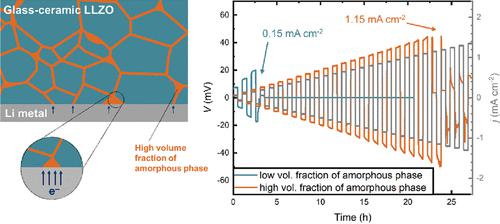当前位置:
X-MOL 学术
›
ACS Appl. Mater. Interfaces
›
论文详情
Our official English website, www.x-mol.net, welcomes your
feedback! (Note: you will need to create a separate account there.)
Amorphous Phase Induced Lithium Dendrite Suppression in Glass-Ceramic Garnet-Type Solid Electrolytes
ACS Applied Materials & Interfaces ( IF 8.3 ) Pub Date : 2023-05-30 , DOI: 10.1021/acsami.3c01667 Nina Hoinkis 1, 2 , Jörg Schuhmacher 1 , Till Fuchs 2 , Sebastian Leukel 1 , Christoph Loho 1 , Andreas Roters 1 , Felix H Richter 2 , Jürgen Janek 2
ACS Applied Materials & Interfaces ( IF 8.3 ) Pub Date : 2023-05-30 , DOI: 10.1021/acsami.3c01667 Nina Hoinkis 1, 2 , Jörg Schuhmacher 1 , Till Fuchs 2 , Sebastian Leukel 1 , Christoph Loho 1 , Andreas Roters 1 , Felix H Richter 2 , Jürgen Janek 2
Affiliation

|
Lithium metal-based solid-state batteries (SSBs) have attracted much attention due to their potentially higher energy densities and improved safety compared with lithium-ion batteries. One of the most promising solid electrolytes, garnet-type Li7La3Zr2O12 (LLZO), has been investigated intensively in recent years. It enables the use of a lithium metal anode, but its application is still challenging because of lithium dendrites that grow at voids, cracks, and grain boundaries of sintered bodies during cycling of the battery cell. In this work, glass-ceramic Ta-doped LLZO produced in a unique melting process was investigated. Upon cooling, an amorphous phase is generated intrinsically, whose composition and fraction are adjusted during the process. Herein, it was set to about 4 wt % containing Li2O and a Li2O–SiO2 phase. During sintering, it was shown to segregate into the grain boundaries and decrease porosity via liquid phase sintering. Sintering temperature and sintering time were found to be reduced compared with the LLZO fabricated by a solid-state reaction while maintaining high density and ionic conductivity. The glass-ceramic sintered at 1130 °C for 0.5 h showed a room-temperature ionic conductivity of 0.64 mS cm–1. Most importantly, the evenly distributed amorphous phase along the grain boundaries effectively hinders lithium dendrite growth. Besides mechanically blocking pores and voids, it helps to prevent inhomogeneous distribution of current density. The critical current density (CCD) of the Li|LLZTO|Li symmetric cell was determined as 1.15 mA cm–2, and in situ lithium plating experiments in a scanning electron microscope revealed superior dendrite stability properties. Therefore, this work provides a promising strategy to prepare a dense and dendrite-suppressing solid electrolyte for future implementation in SSBs.
中文翻译:

玻璃陶瓷石榴石型固体电解质中非晶相诱导的锂枝晶抑制
与锂离子电池相比,锂金属基固态电池 (SSB) 因其潜在的更高能量密度和更高的安全性而备受关注。最有前途的固体电解质之一,石榴石型Li 7 La 3 Zr 2 O 12(LLZO),近年来得到了深入研究。它可以使用锂金属负极,但由于锂枝晶在电池循环过程中会在烧结体的空隙、裂缝和晶界处生长,因此其应用仍然具有挑战性。在这项工作中,研究了在独特的熔化工艺中生产的掺 Ta 微晶玻璃 LLZO。冷却后,本质上会产生非晶相,其组成和分数会在该过程中进行调整。在此,它被设置为包含 Li 2 O 和 Li 2 O–SiO 2的约 4 wt%阶段。在烧结过程中,它显示出偏析到晶界中并通过液相烧结降低孔隙率。与通过固态反应制造的 LLZO 相比,发现烧结温度和烧结时间减少,同时保持高密度和离子电导率。在 1130 °C 下烧结 0.5 小时的微晶玻璃表现出 0.64 mS cm –1的室温离子电导率。最重要的是,沿晶界均匀分布的非晶相有效地阻碍了锂枝晶的生长。除了机械地阻塞孔隙和空隙外,它还有助于防止电流密度分布不均匀。Li|LLZTO|Li 对称电池的临界电流密度 (CCD) 被确定为 1.15 mA cm –2,并且原位扫描电子显微镜中的锂电镀实验显示出优异的枝晶稳定性。因此,这项工作为制备致密且抑制枝晶的固体电解质提供了一种有前途的策略,以供将来在 SSB 中实施。
更新日期:2023-05-30
中文翻译:

玻璃陶瓷石榴石型固体电解质中非晶相诱导的锂枝晶抑制
与锂离子电池相比,锂金属基固态电池 (SSB) 因其潜在的更高能量密度和更高的安全性而备受关注。最有前途的固体电解质之一,石榴石型Li 7 La 3 Zr 2 O 12(LLZO),近年来得到了深入研究。它可以使用锂金属负极,但由于锂枝晶在电池循环过程中会在烧结体的空隙、裂缝和晶界处生长,因此其应用仍然具有挑战性。在这项工作中,研究了在独特的熔化工艺中生产的掺 Ta 微晶玻璃 LLZO。冷却后,本质上会产生非晶相,其组成和分数会在该过程中进行调整。在此,它被设置为包含 Li 2 O 和 Li 2 O–SiO 2的约 4 wt%阶段。在烧结过程中,它显示出偏析到晶界中并通过液相烧结降低孔隙率。与通过固态反应制造的 LLZO 相比,发现烧结温度和烧结时间减少,同时保持高密度和离子电导率。在 1130 °C 下烧结 0.5 小时的微晶玻璃表现出 0.64 mS cm –1的室温离子电导率。最重要的是,沿晶界均匀分布的非晶相有效地阻碍了锂枝晶的生长。除了机械地阻塞孔隙和空隙外,它还有助于防止电流密度分布不均匀。Li|LLZTO|Li 对称电池的临界电流密度 (CCD) 被确定为 1.15 mA cm –2,并且原位扫描电子显微镜中的锂电镀实验显示出优异的枝晶稳定性。因此,这项工作为制备致密且抑制枝晶的固体电解质提供了一种有前途的策略,以供将来在 SSB 中实施。


















































 京公网安备 11010802027423号
京公网安备 11010802027423号